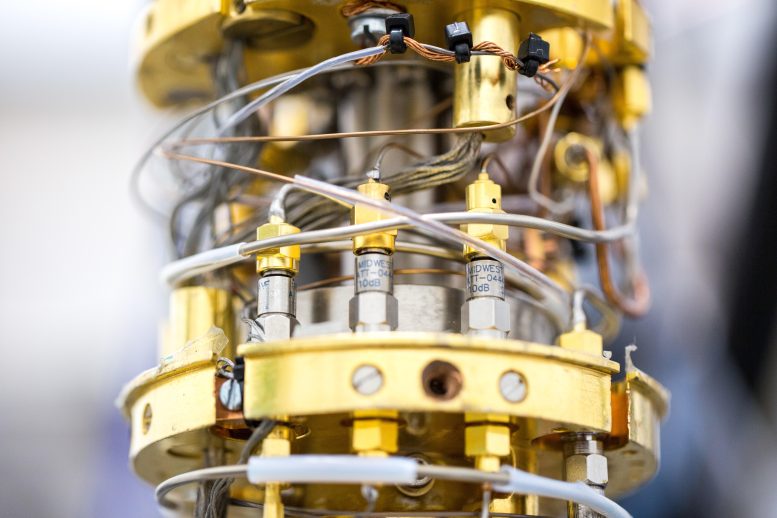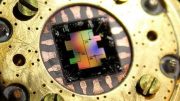
Aalto University quantum researchers use quantum coherence to detect objects without looking at them. Credit: Mikko Raskinen/Aalto University.
The newly developed method links quantum and classical worlds and may enhance measurements for quantum computers and other applications.
Our vision is made possible by the specialized cells in our retina that absorb light. But, can one see without any absorption of light or even a single photon? Surprisingly, the answer is yes.
Suppose you have a camera cartridge that could hold a roll of photographic film. The film is so delicate that even a single photon could damage it. Using conventional methods, it’s impossible to determine if there’s film in the cartridge. However, in the quantum world, it can be achieved. Anton Zeilinger, a Nobel Prize winner in Physics 2022, was the first to experimentally implement the idea of an interaction-free experiment using optics.
Now, in a study exploring the connection between the quantum and classical worlds, Shruti Dogra, John J. McCord, and Gheorghe Sorin Paraoanu of Aalto University have discovered a new and much more effective way to carry out interaction-free experiments. The team used transmon devices –superconducting circuits that are relatively large but still show quantum behavior– to detect the presence of microwave pulses generated by classical instruments. Their research was recently published in Nature Communications.
An experiment with an added layer of “quantumness”
Although Dogra and Paraoanu were fascinated by the work done by Zeilinger’s research group, their lab is centered around microwaves and superconductors instead of lasers and mirrors. ‘We had to adapt the concept to the different experimental tools available for superconducting devices. Because of that, we also had to change the standard interaction-free protocol in a crucial way: we added another layer of “quantumness” by using a higher energy level of the transmon. Then, we used the quantum coherence of the resulting three-level system as a resource,’ Paraoanu says.
Quantum coherence refers to the possibility that an object can occupy two different states at the same time – something that quantum physics allows for. However, quantum coherence is delicate and easily collapses, so it wasn’t immediately obvious that the new protocol would work. To the team’s pleasant surprise, the first runs of the experiment showed a marked increase in detection efficiency. They went back to the drawing board several times, ran theoretical models confirming their results, and double-checked everything. The effect was definitely there.
‘We also demonstrated that even very low-power microwave pulses can be detected efficiently using our protocol,’ says Dogra.
The experiment also showed a new way in which quantum devices can achieve results that are impossible for classical devices – a phenomenon known as quantum advantage. Researchers generally believe that achieving quantum advantage will require quantum computers with many qubits, but this experiment demonstrated genuine quantum advantage using a relatively simpler setup.
Potential applications in many types of quantum technology
Interaction-free measurements based on the less effective older methodology have already found applications in specialized processes such as optical imaging, noise detection, and cryptographic key distribution. The new and improved method could increase the efficiency of these processes dramatically.
‘In quantum computing, our method could be applied for diagnosing microwave-photon states in certain memory elements. This can be regarded as a highly efficient way of extracting information without disturbing the functioning of the quantum processor,’ Paraoanu says.
The group led by Paraoanu is also exploring other exotic forms of information processing using their new approach, such as counterfactual communication (communication between two parties without any physical particles being transferred) and counterfactual quantum computing (where the result of a computation is obtained without in fact running the computer).
Reference: “Coherent interaction-free detection of microwave pulses with a superconducting circuit” by Shruti Dogra, John J. McCord and Gheorghe Sorin Paraoanu, 7 December 2022, Nature Communications.
DOI: 10.1038/s41467-022-35049-z









For centuries, symmetries have allowed physicists to find underlying connections and fundamental relationships throughout the universe. Particles are not fixed, immutable things. They have a real history, and can only be properly understood by studying how they change in time. In physics, topological vortex and anti-vortex fields always appear in pairs. They perfectly reflect the exact symmetry under the simultaneous transformation of parity conservation (P), charge conjugation (C) and time reversal (T). The interactions and balances of topological vortex fields cover all short-distance and long-distance contributions, and are the basis of the formation and evolution of cosmic matter. With the deepening of the research on the interaction of topological vortex field, human science’s understanding about the nature of the law of matter movement will expected to be solved in a perfect way in topological space-time.